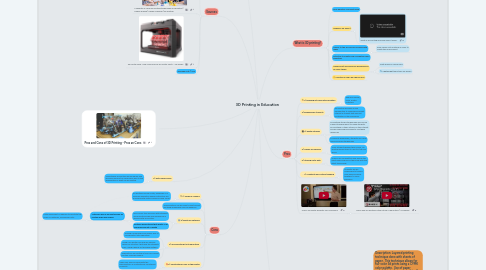
1. 2) Extra Supervision
1.1. Using these 3D printers would require and immense amount of supervision due to the possibilities of what can be printed
2. Pros and Cons of 3D Printing - Pros an Cons
3. Applications
3.1. 3D printing for instruction assists better with getting students ready for their future by making models
3.2. 3D printing allows students to express thoughts and pictures on a page or screen, considering the formation of those thoughts or pictures in the physical 3-dimensional world
3.3. Colleges have 3D printers accessible for students to use in classes and projects
3.3.1. Organizations, for example, MakerBot offer confirmation courses in 3D printing
3.4. 3D printing is changing STEM instruction by offering the capacity for minimal effort and fast prototyping
3.4.1. 1) By incorporating 3D printing, students are encouraged to become "inventors"
3.4.1.1. Creating interest in careers like engineering, STEM, or medical technology
3.5. Understudies investigate configuration, building, and structural standards.
3.5.1. They can copy exhibition hall things like fossils and authentic antiques to examine in the homeroom without the probability of harming fragile assortments. They can increase another, 3-dimensional viewpoint on topographic maps.
3.6. Visual computerization students can develop models with complex working parts
3.6.1. Students in the sciences can make and concentrate cross-segments of organs in the human body just as other natural examples
3.6.1.1. Science understudies can make 3D models of particles and substance mixes
4. Sources
4.1. 3D Printing Industry-The Authority on 3D Printing & Additive Manufacturing
4.2. 7 benefits of using 3D printing technology in Education | Makers Empire | Design Thinking | 3D Printing
4.3. 3D Printer Price: How Much Does a 3D Printer Cost? - 3D Insider
4.4. Average cost: $700
5. Cons
5.1. 1) Funds in Schools
5.1.1. 3D printing can be costly, especially in a field like education where instructors are provided with limited resources and funds
5.2. These printers can be used to print almost anything imaginable such as weapons
5.3. 3) Waste of materials
5.3.1. Errors from trial and error with students and educators who lack experience in dealing with 3D printers
5.3.1.1. Materials used in 3D printing can be melted down and reused.
5.3.1.1.1. Extra equipment is required to facilitate the reuse of materials, increasing costs.
5.3.2. Printing useless items that results in an immense amount of waste
5.4. 4) Incorporating it into education
5.4.1. Finding a meaningful and useful way to incorporate it into education
5.4.2. Using a 3D printer can and will replace hands on activities that help the students learn using a hands on teaching method
5.4.3. Applications are limited in terms of classes printers could be used in.
5.5. 5) Unintentional uses of the printer
5.5.1. There can also be issues with the reproduction of unintentional counterfeit products
6. What is 3D printing?
6.1. AKA Additive Manufacturing
6.2. Making a 3D object
6.2.1. What is 3D Printing and how does it work?
6.3. Similar to the process of building with legos
6.3.1. Adds layers onto material in order to create the final product
6.4. Potential to create new occupations and industries
6.5. Lowers cost and improves performance of some things
6.5.1. Shift knobs on racing cars
6.5.2. Lightweight table trays on planes
6.6. Invented in 1984 by Charles Hull
7. Pros
7.1. 2) Bringing art back into education
7.1.1. Requires design, color, plastic materials
7.2. 3) Engaging all students
7.2.1. 3D printing provides a new perspective to learning and might interest a student that has lost motivation in the classroom
7.3. 4) Digital citizens
7.3.1. 3D printing utilizes technology and can be a good teaching point to make students accountable of their actions on the Internet and be responsible enough to use these resources
7.3.2. As society progresses, students are using more and more technology
7.4. 5) Hands-on learning
7.4.1. Once students design their model, 3D printing allows them to use it in the real world
7.5. 6) Staying up to date
7.5.1. Schools are competitive and having this asset keeps schools in the know with the latest technology
7.6. 7) Creativity and critical thinking
7.6.1. Students will be challenged to think in new ways and work together to solve problems
7.7. How a 3D printer benefits your classroom
7.7.1. This is why 3D printing is the Future of Education | Vocademy
8. Printing Technique
8.1. Technique 1: Selective Deposition Lamination (SDL)
8.1.1. Description: Layered printing technique done with sheets of paper. This technique allows for full-color 3d prints using a CYMK color palette. Use of paper makes this technique eco-friendly. Prints are however, limited by the size of the feedstock, and this method does not allow for complex shapes.
8.1.2. Process:
8.1.2.1. 1) Sheet of paper is added to the platform
8.1.2.2. 2) Adhesive is added
8.1.2.3. 3) Heat and pressure are applied to surface
8.1.2.4. 4) Blade cuts through each page at a time
8.1.2.5. 5) Process repeats until product is all that remains
8.2. Technique 2: Extrusion (FDM/FFF)
8.2.1. Description:
8.2.2. Process:
8.2.2.1. 1) A plastic filament spool is loaded into the printer
8.2.2.2. 2) The filament is melted by the extruder
8.2.2.3. 3) The extruder deposits melted material onto a build platform according to 3D data provided to the printer
8.2.2.4. 4) Each layer solidifies as it is deposited, while also bonding to the previous layer
8.2.2.5. 5) The print is left to cool until all layers have solidified. It is now complete
8.3. Technique 3: Material Jetting
8.3.1. Description:
8.3.2. Process:
8.4. Technique 4: Binder Jetting
8.4.1. Description:
8.4.2. Process:
